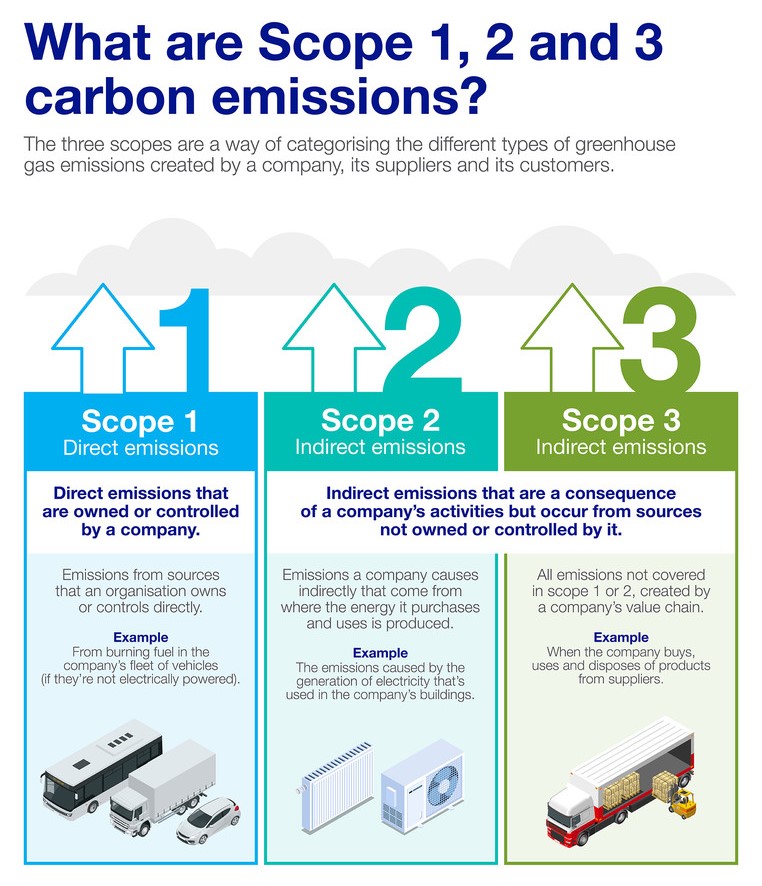
As businesses and organizations strive to meet global sustainability goals, one of the most important aspects they need to understand is carbon emissions. In particular, the categorization of emissions into Scope 1, Scope 2, and Scope 3 helps organizations track their environmental impact more precisely and take targeted actions to reduce their carbon footprint.
Let’s break down these categories and explore how your business can address emissions across all three scopes.
What are Scope 1, 2, and 3 Emissions?
The concept of Scope 1, 2, and 3 emissions was established by the Greenhouse Gas (GHG) Protocol. It provides a clear framework for organizations to measure and manage their carbon emissions based on the sources of those emissions.
-
Scope 1: Direct emissions from owned or controlled sources
-
Scope 2: Indirect emissions from the generation of purchased energy
-
Scope 3: Indirect emissions that occur along the value chain, both upstream and downstream
Understanding these categories is the first step for any organization that is serious about reducing its environmental impact.
Scope 1: Direct Emissions from Owned or Controlled Sources
Scope 1 emissions are those that come directly from sources owned or controlled by the company. These are the emissions that result from activities or processes within the organization itself. Examples of Scope 1 emissions include:
-
Fuel combustion: Emissions from vehicles, machinery, or on-site power generation.
-
Industrial processes: Emissions from chemical reactions or other manufacturing processes.
-
Waste management: Emissions from the disposal or treatment of waste materials.
Managing Scope 1 emissions involves making decisions that directly affect the operations of the business. To reduce Scope 1 emissions, companies can:
-
Transition to renewable energy sources such as solar or wind power.
-
Upgrade industrial equipment to be more energy-efficient, minimizing energy waste.
-
Invest in electric or hybrid vehicles for transportation needs.
-
Implement low-carbon technologies in manufacturing processes.
By focusing on cleaner and more efficient practices, companies can make a meaningful impact in reducing their direct carbon emissions.
Scope 2: Indirect Emissions from Purchased Energy
Scope 2 emissions refer to the indirect emissions generated when the organization consumes energy purchased from an external source. This typically includes emissions from electricity, heating, and cooling used across company facilities. These emissions are indirectly tied to the company but still play a crucial role in its overall carbon footprint.
Examples of Scope 2 emissions include:
-
Electricity usage in office buildings, factories, or other facilities.
-
Heating and cooling systems that rely on non-renewable energy sources.
While Scope 2 emissions are outside of the direct control of an organization, companies can still reduce their footprint by:
-
Switching to renewable energy through Power Purchase Agreements (PPAs) or purchasing Renewable Energy Certificates (RECs).
-
Improving energy efficiency through upgrades like LED lighting, insulation, and energy-efficient HVAC systems.
-
Generating on-site renewable energy such as installing solar panels or wind turbines.
Addressing Scope 2 emissions is a vital step for businesses committed to sustainability. By using cleaner energy, organizations can significantly reduce their overall carbon impact.
Scope 3: Indirect Emissions Across the Value Chain
Scope 3 emissions are the most complex to track and manage since they arise from activities that are outside the organization’s direct control. These emissions occur along the entire value chain—both upstream (e.g., emissions from suppliers) and downstream (e.g., emissions from the use of sold products).
Examples of Scope 3 emissions include:
-
Supply chain emissions: Emissions from the production, transportation, and storage of goods and services provided by suppliers.
-
Product use and disposal: Emissions that occur when customers use products or dispose of packaging.
-
Employee travel: Emissions from business trips, whether by car, train, or air.
Despite their complexity, reducing Scope 3 emissions is crucial for businesses aiming to achieve comprehensive sustainability.
Here’s how organizations can address these emissions:
-
Engage suppliers to help track and reduce emissions from the production and transportation of materials.
-
Design products for sustainability by ensuring they are energy-efficient, durable, and recyclable.
-
Optimize logistics and reduce transportation emissions by using eco-friendly transportation options and improving supply chain efficiency.
-
Encourage sustainable consumer behaviors by providing recycling options and educating consumers on environmentally friendly disposal methods.
Reducing Scope 3 emissions requires collaboration throughout the value chain, but the impact can be transformative for both the business and the planet.
How Can Your Organization Reduce Scope 1, 2, and 3 Emissions?
While reducing emissions in all three scopes may seem challenging, it’s entirely possible with a well-thought-out strategy.
Here are a few steps your business can take:
-
Carbon Accounting: Start by measuring emissions across all three scopes to understand your current impact. This will provide a clear baseline from which to set goals and track progress.
-
Set Clear Targets: Establish realistic and measurable emissions reduction targets for each scope. Regularly track and review your progress.
-
Collaborate Across the Supply Chain: Work closely with suppliers, customers, and employees to reduce emissions throughout your value chain.
-
Implement Sustainable Practices: Adopt cleaner energy sources, improve energy efficiency, and embrace sustainable product design. Every action counts.
Scope 1, 2, and 3 emissions form the foundation for any organization’s approach to managing its carbon footprint. Understanding where emissions originate, and taking proactive steps to reduce them across all three scopes, is essential for businesses committed to sustainability. By focusing on direct emissions, purchasing cleaner energy, and collaborating with suppliers and consumers, your business can play a critical role in addressing climate change.
Reducing emissions is not just about corporate responsibility; it’s also about ensuring a sustainable future for generations to come. As a company, the actions you take today will help drive the change that’s needed to protect our planet.

